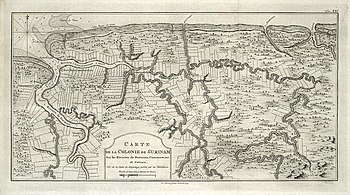HMS Emerald (1795)
Emerald was supposed to have been present at the Battle of the Nile but in May 1798 a storm separated her from Horatio Nelson's squadron and she arrived in Aboukir Bay nine days too late.
Emerald served in the Caribbean throughout 1803 in Samuel Hood's fleet, then took part in the invasion of St Lucia in July, and of Surinam the following spring.
Returning to home waters for repairs in 1806, she served in the Western Approaches before joining a fleet under Admiral James Gambier in 1809, and taking part in the Battle of the Basque Roads.
In April, she took a convoy to the River Tagus and continued to perform escort duties for some months after, before sailing to the Mediterranean in January 1797 and joining Admiral John Jervis's fleet at Gibraltar.
[9][e] Following the Battle of Cape St Vincent, the British pursued the remainder of the Spanish fleet to Cádiz, where Jervis began a long-running blockade of the port.
[12] The Spanish ships sought shelter from the British north of Trafalgar in Conil Bay, the entrance to which was protected by a large rocky ledge.
[14][15] The British took Ninfa into service as HMS Hamadryad, a 36-gun frigate with a main battery of 12-pounders,[13][16] but were unable to retrieve the cargo of silver, which later arrived safely in Cádiz.
[18] During a second bombardment on the night of 5 July, Emerald, in the company of Terpsichore and the 74-gun Theseus, provided a protective escort for three bomb vessels, Thunder, Terror and Strombolo.
[23] While serving with Jervis on the Lisbon station in December 1797, Emerald, under the temporary command of Lord William Proby, captured the 8-gun privateer, Chasseur Basque.
[1] In May, Jervis dispatched a squadron of five ships, including Emerald and commanded by Nelson in the 74-gun Vanguard, to locate a large invasion fleet that had left Toulon.
When they launched their boats to cut-out Anėmone, her crew cut the anchor cable and their ship drifted on to the shore; as the Frenchmen were attempting to escape along the coast, hostile Arabs captured them and stripped them of their clothes, shooting those who resisted.
A heavy surf prevented the British boats from landing, so a midshipman from Emerald, the young Francis Fane, swam ashore with a line and empty cask to rescue the commander and seven others who had escaped naked to the beach.
[41] Duckworth ordered Emerald to take a parallel course to the enemy frigates in anticipation of a dawn attack, and at first light, the British closed with their opponents.
Emerald immediately set off in pursuit but Duckworth recalled her and instead ordered her to locate the merchant ships; she secured four of the largest vessels by nightfall.
[45] Emerald was recommissioned in December 1800 under Captain James O'Bryen and early in 1801, escorted a convoy of 110 ships to the West Indies Station, where she continued in service during the short-lived Peace of Amiens.
[52] While in the company of the 22-gun brig HMS Heureux, Emerald intercepted and captured a Dutch merchant vessel travelling between Surinam and Amsterdam on 10 August.
[58] Contrary winds prevented the privateer, Mosambique, from entering St Pierre and she had sought shelter beneath the batteries at Seron.
The invasion force consisted of Hood's flagship Centaur, Emerald, the 44-gun heavy frigates Pandour and Serapis, the 28-gun sixth-rate Alligator, the 12-gun schooner Unique, the 12-gun corvette Hippomenes, and the 8-gun Drake, together with 2,000 troops under Brigadier-General Sir Charles Green.
[61][62] The sloop Hippomenes, a transport and a further three armed vessels, landed Brigadier-General Frederick Maitland and 700 troops at Warapee Creek on the night of 30 April.
[61][63] Emerald, Pandour, and Drake then pushed up the river, sometimes in less water than the frigates required to float properly, until on 5 May they arrived close to the forts Leyden and Frederici.
The British landed a detachment of troops under Hughes some distance away, which marching under the cover of the forests and swamps, launched an attack that resulted in the swift capture of the two forts.
[47] They reached the stopping off point, Madeira, in December and while moored in Funchal Bay, a merchant ship collided with Emerald, taking out the quarter gallery on the left-hand side and carrying away the cutter.
[1][70] Emerald spent much of her time under Maitland cruising in the Western Approaches and in the Bay of Biscay, off the Atlantic coast of France, where she preyed on enemy shipping.
[1][76] Austerlitz had been out of port two days but had made no captures; the polacca was the Spanish ship Prince of Asturias, which had sailed from La Guayra with a cargo of cocoa, bark and indigo.
[81] In 1847 the Admiralty issued the clasp "Emerald 13 March 1808" to the Naval General Service Medal to the ten surviving claimants from the action.
[86] The French force comprised eight ships of the line and two frigates, and Stopford immediately sent Naiad to apprise Admiral James Gambier of the situation.
[92] The French ships were anchored under the protection of the powerful batteries on the Isle d'Aix[93] when on 11 April Lord Cochrane attacked them with fireships and explosive vessels.
[o] Emerald took up position ahead of Indefatigable and behind Aigle and Unicorn, and directed her fire mainly towards the French ships of the line, Varsovie and Aquilon, both of which struck at around 17:30.
[98] At 20:00, Emerald, along with the other British frigates and brigs, weighed and anchored with the 74-gun HMS Revenge in the Maumusson passage to the south of Oléron while a second fireship attack was under preparation.
[122][123][t] The journey to the Cape Colony, proved to be Emerald's last duty of note; she returned home in November 1811, and after transporting the captain's wine to the custom house in Portsmouth, was laid up in ordinary.






